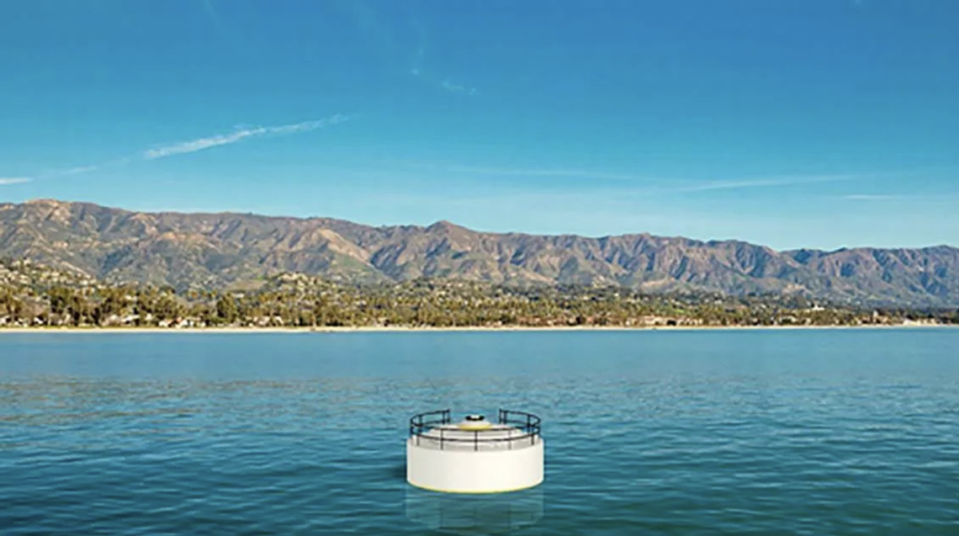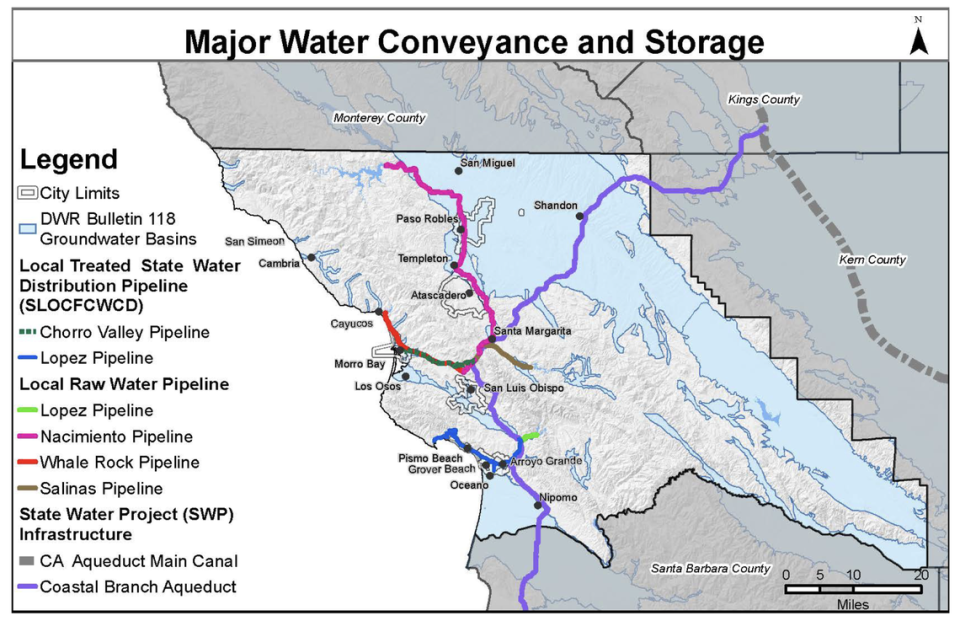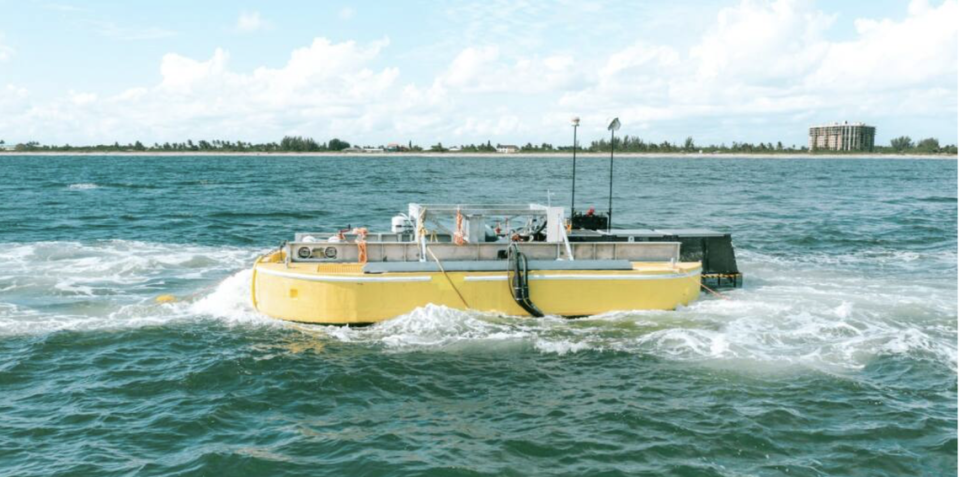SLO County gets big grant to study desalination and water reuse projects
This month, the U.S. Bureau of Reclamation announced that San Luis Obispo County was among 31 Western U.S. planning projects to receive $28.9 million in funding to support potential new water reuse and desalination projects.
SLO County was awarded $550,000 in matching funds to start a feasibility, technology and project location study to take advantage of our over 80 miles of ocean frontage that could help transform seawater into drinking water.
With the prospect of future droughts due to global warming, “this renewable, almost inexhaustible resource would not be diminished by climate change, insufficient rainfall, or water conservation efforts,” says Angela Ford, SLO DESAL (Desalination Executable Solution and Logistics) Plan manager and supervising water resources engineer with the county.
In the Western U.S., record temperatures and drought conditions have forced states like California to plan for a future with dwindling water supplies even though current conditions are flush with nearly full reservoir supply across the state. Water users in the county have reduced per-capita water use by 30% since 2009 and are meeting state water use efficiency goals as limited new supplies other than recycled water remain.
The DESAL project will examine alternate sites, different technology options, and whether there’s a regional benefit that could help many water districts, Ford said.
“Recent technological advances have also made it more sustainable, energy-efficient and less impactful on the environment to turn seawater into drinking water than ever before,” the county DESAL Plan report says.
The California Coastal Commission had objected to the potential harmful impact from some of these projects, but new technology appears to have eased those fears. Last fall the commission issued a permit for a $140 million desalination plant off the coast of Dana Point.
In one technique to mitigate environmental impacts from open water intakes and outfalls, subsurface wells could be used to collect water from the ocean or other saline surface water.

Desalination becoming more financially feasible
In addition, the rising cost of treating and conveying water from other sources has “made seawater desalination more economically feasible compared to other new supply alternatives.”
Over the past decade, the San Luis Obispo County Board of Supervisors has expressed interest in desalination as a water supply opportunity.
In November 2021, the board identified water resilience and desalination as a top priority. Then, as of October 2022, the board agreed to proceed on the path to a desalination project and seek resolutions from local agencies who might want to join the study.
The board also authorized grant applications.
Now agencies from around the county have signed up to participate in a two-year study that could lead to one or more regional projects down the road.
DESAL Plan participants include the cities of Arroyo Grande, Morro Bay, Paso Robles and San Luis Obispo; community services districts from Los Osos, Avila Beach, Cambria, Nipomo, San Miguel and Templeton; the Atascadero Mutual Water Co.; the Golden State Water Co.; the San Miguelito Mutual Water Co.; and Santa Barbara County.
First look at locations
So far, potential locations for desalination opportunities in SLO County include some mothballed seaside sites.
Among the possibilities are:
Expansion of the Morro Bay Desalination Facility
Expansion of the Cambria Emergency Water Supply Project
Expansion of the Diablo Canyon Power Plant desalination facility
Co-location at the South San Luis Obispo County Wastewater Treatment Plant
Co-location at the Nipomo Mesa Refinery
Co-location at the Morro Bay Power Plant
A new facility at the Estero Marine Terminal
A key strategy for the effort is to take advantage of connecting water delivery infrastructure already in place between communities, reservoirs and water systems that could help spread the benefit of this new water supply.
“Existing infrastructure that could facilitate exchanges with inland participants includes participants in the Nacimiento Project, State Water Project Coastal Branch, and Lopez Project as well as supplemental supplies for groundwater sustainability agencies, which include municipal, domestic, industrial, and agricultural users,” the county DESAL Plan report says. “Environmental and fish and wildlife uses from the Lopez Project may be identified in the Arroyo Grande Creek Habitat Conservation Plan and could be met via exchange with desalination. Also, desalinated water could be recharged in local groundwater basins for storage or provide in-lieu groundwater recharge where desalinated water replaces pumping of groundwater.”

How SLO County water sources are connected
A map of SLO County shows how local communities and water sources are mostly connected with some exceptions like Cambria and Los Osos.
Los Osos looks to correct this in the near future by connecting to the State Water Project in Morro Bay. Funding from the federal Government will enable the county to hire an expert consultant to help engage local stakeholders to develop and describe concept alternatives.
Alternatives include, but are not limited to:
Direct delivery to near-coastal communities only
Direct delivery to near-coastal communities with inland investors to free up existing supplies currently going to near-coastal communities
Onshore and offshore facility options
Co-located facility and new site options
Currently, California has 14 seawater and 23 brackish water desalination plants, but not all operate at full capacity, according to a report.
The city of Antioch is building the state’s first inland brackish water desalination project at a cost of about $110 million.
Other potential sources for desalinated water may include brackish groundwater or inland surface water bodies, bays and estuaries, according to a staff report.
The identification and investigation of brackish water sources is important for any given project to consider as lower energy is required to desalinate sources with lower salinity.
During the analysis of inland wells, it will be important to consider any impacts to the fresh groundwater.
The county has three groundwater basins designated as critically overdrafted by the state and 12 basins with potential seawater intrusion issues that can be potentially mitigated with desalination.
“We have no groundwater banking like they have in the San Joaquin Valley,” said Ford, which means more surface storage is required to store imported water.
In Los Osos the community might soon be able to hook up to state water that is delivered to the South Coast including to Morro Bay and both San Luis Obispo and Santa Barbara counties to supplement local supplies.
That pipeline to Los Osos could be used to bring in desal water from a future regional offshore facility near Morro Bay, for example.
The local CSD says it wants to use the pipeline connected to the State Water Project to recharge the community aquifer and help to stave off seawater intrusion.
The county relies primarily on five reservoirs for surface water supplies — Lake Nacimiento, Whale Rock Reservoir, Lopez Lake, Santa Margarita Lake and Chorro Reservoir — and any decrease in the use of water from these sources that may be offset by desalinated water would result in higher reservoir levels, improved flows, and enhanced habitat conditions for wildlife within the watershed.
In addition, the district has an annual allocation of 25,000 acre-feet of water from the State Water Project, fed by the San Luis Reservoir near Los Banos.
The reservoir is brimming with water now after a record mountain runoff.
What’s next?
As part of the Phase 2 of the DESAL Plan development, the county will now investigate and evaluate saline and brackish water sources, treatment technologies, and uses for the treated water.
Planning activities will include developing and implementing a public and stakeholder engagement process, developing ranking criteria for concept alternatives, identifying concept alternatives, and developing a short list of preferred projects to further pursue.
Angela Ford cautioned that a final operating project or projects are likely decades away, although a “preferred project” might be known by 2026.
Start-up projects to watch
As guidance, the county will be able to look to several on- or near-shore desal technologies that are being tested off the California coast this fall.
They include the SeaWell project based in Santa Barbara and the Calabasas-based OceanWell project with the Las Virgenes Municipal Water District, a partnership to pilot California’s first-ever Blue Water farm.
Blue Water farms say they use water pressure at depths of over 1,000 feet to drive the reverse osmosis process while safeguarding marine life and protecting delicate aquatic ecosystems.
They argue that the system is reliable, low energy, easily scalable, negates the need for an onshore plant, and produces no harmful impacts.
A pilot project announced this summer will start testing the state-of-the-art technology in the District’s Las Virgenes Reservoir in the city of Westlake Village.
Meanwhile, a wave-powered desal project is underway off the Mendocino coast.

This summer, the city of Fort Bragg received $1.5 million in state funding to launch a pilot project to supplement local drinking supplies using wave-powered desalination technology aboard a floating raft-like unit anchored a mile offshore.
Closer to home, SeaWell’s small offshore desalination buoy project with Vandenberg Space Force Base got the support of local Congressman Salud Carbajal, who submitted a letter to base command in July.
Announced a year ago, the Vandenberg seawater project’s initial engineering is said to be complete, with the final report pending in the next few weeks.
An offshore bouy or bouys would supplement the base’s limited groundwater supply. SeaWell says the report will provide a basis to begin pre-permitting discussions with the State Lands Commission.
Seawell’s CEO Peter Stricker says the company’s technology “advances beyond shoreside mega-desalination plants to environmentally friendly, dispersed, floating seawater conversion buoys, each delivering freshwater for over 5,000 homes with unrivaled energy efficiency.”
SeaWell is also working with the U.S. Navy at the Navy’s Seawater Desalination Test Facility at Port Hueneme.
Time will tell if these innovative approaches to supply drinking water from the ocean will work and be cost-effective.
John Lindt is the editor of the news site Sierra2theSea.net.

